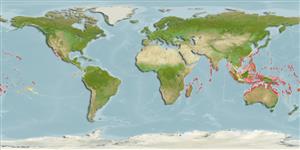>
Ovalentaria/misc (Various families in series Ovalentaria) >
Pomacentridae (Damselfishes) > Microspathodontinae
Etymology: Plectroglyphidodon: Greek,plektron = anything to strike with, spur + Greek, glyphis = carved + Greek, odous = teeth (Ref. 45335).
More on authors: Fowler & Ball.
Environment: milieu / climate zone / depth range / distribution range
Ecologia
marino associati a barriera corallina; non migratori; distribuzione batimetrica 0 - 30 m (Ref. 128797). Tropical; 30°N - 30°S
Indo-Pacific: East Africa to the Hawaiian, Marquesan, and Pitcairn islands, north to the Ryukyu and Bonin islands, south to Lord Howe Island and Rapa. Unknown from the Red Sea, Persian Gulf and Gulf of Oman (Ref. 11441).
Size / Peso / Age
Maturity: Lm ? range ? - ? cm
Max length : 14.0 cm TL maschio/sesso non determinato; (Ref. 11441)
Short description
Chiavi di identificazione | Morfologia | Morfometria
Spine dorsali (totale) : 12; Raggi dorsali molli (totale) : 17 - 19; Spine anali: 2; Raggi anali molli: 16 - 18.
Adults are found clear water, inner to outer reef crests in rich coral habitat (Ref. 48636). Benthopelagic (Ref. 58302). Common in passages, frequently associated with Acropora, Stylophora, or Pocillopora coral heads or a single head of Pocillopora eydouxi (= Pocillopora grandis). Usually seen solitary (Ref. 48636). Feed on benthic algae and probably coral polyps. Oviparous, distinct pairing during breeding (Ref. 205). Eggs are demersal and adhere to the substrate (Ref. 205). Males guard and aerate the eggs (Ref. 205). Diurnal species (Ref. 13550).
Life cycle and mating behavior
Maturità | Riproduzione | Deposizione | Uova | Fecundity | Larve
Oviparous, distinct pairing during breeding (Ref. 205). Eggs are demersal and adhere to the substrate (Ref. 205). Males guard and aerate the eggs (Ref. 205).
Allen, G.R., 1991. Damselfishes of the world. Mergus Publishers, Melle, Germany. 271 p. (Ref. 7247)
IUCN Red List Status (Ref. 130435: Version 2024-2)
Threat to humans
Harmless
Human uses
Pesca: di nessun interesse; Acquario: Commerciale
Strumenti
Special reports
Download XML
Fonti Internet
Estimates based on models
Preferred temperature (Ref.
123201): 24.7 - 29.2, mean 28.2 °C (based on 2485 cells).
Phylogenetic diversity index (Ref.
82804): PD
50 = 0.5010 [Uniqueness, from 0.5 = low to 2.0 = high].
Bayesian length-weight: a=0.02188 (0.01190 - 0.04023), b=2.95 (2.79 - 3.11), in cm total length, based on LWR estimates for this species & (Sub)family-body (Ref.
93245).
Trophic level (Ref.
69278): 3.4 ±0.6 se; based on diet studies.
Resilienza (Ref.
120179): Alto, tempo minimo di raddoppiamento della popolazione meno di 15 mesi (Preliminary K or Fecundity.).
Fishing Vulnerability (Ref.
59153): Low vulnerability (10 of 100).
Nutrients (Ref.
124155): Calcium = 91.4 [46.7, 145.6] mg/100g; Iron = 0.68 [0.40, 1.10] mg/100g; Protein = 18.6 [17.4, 19.7] %; Omega3 = 0.114 [0.069, 0.182] g/100g; Selenium = 21.5 [12.4, 40.0] μg/100g; VitaminA = 92.1 [27.5, 293.1] μg/100g; Zinc = 1.43 [0.97, 2.06] mg/100g (wet weight);
